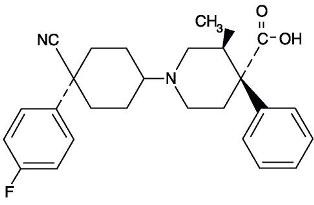Livostin
Livostin
FULL PRESCRIBING INFORMATION: CONTENTS*
- LIVOSTIN DESCRIPTION
- CLINICAL PHARMACOLOGY
- LIVOSTIN INDICATIONS AND USAGE
- LIVOSTIN CONTRAINDICATIONS
- WARNING
- PRECAUTIONS
- PREGNANCY
- LIVOSTIN ADVERSE REACTIONS
- LIVOSTIN DOSAGE AND ADMINISTRATION
- HOW SUPPLIED
FULL PRESCRIBING INFORMATION
LIVOSTIN®
0.05% (levocabastine hydrochloride ophthalmic suspension)
LIVOSTIN DESCRIPTION
LIVOSTIN™ 0.05% (levocabastine hydrochloride ophthalmic suspension) is a selective histamine H1-receptor antagonist for topical ophthalmic use. Each mL contains 0.54 mg levocabastine hydrochloride equivalent to 0.5 mg levocabastine; 0.15 mg benzalkonium chloride; propylene glycol; polysorbate 80; dibasic sodium phosphate, anhydrous; monobasic sodium phosphate, monohydrate; disodium edetate; hydroxypropyl methylcellulose; and purified water. It has a pH of 6.0 to 8.0.
The chemical name for levocabastine hydrochloride is (–)-trans-1-[cis-4-Cyano-4- (p-fluorophenyl)cyclohexyl]-3-methyl-4-phenylisonipecotic acid monohydrochloride, and is represented by the following chemical structure:
 | ● HCl |
CLINICAL PHARMACOLOGY
Levocabastine is a potent, selective histamine H1-antagonist.
Antigen challenge studies performed two and four hours after initial drug instillation indicated activity was maintained for at least two hours.
In an environmental study, LIVOSTIN™ 0.05% (levocabastine hydrochloride ophthalmic suspension) instilled four times daily was shown to be significantly more effective than its vehicle in reducing ocular itching associated with seasonal allergic conjunctivitis.
After instillation in the eye, levocabastine is systemically absorbed. However, the amount of systemically absorbed levocabastine after therapeutic ocular doses is low (mean plasma concentrations in the range of 1-2 ng/mL).
LIVOSTIN INDICATIONS AND USAGE
LIVOSTIN™ 0.05% (levocabastine hydrochloride ophthalmic suspension) is indicated for the temporary relief of the signs and symptoms of seasonal allergic conjunctivitis.
LIVOSTIN CONTRAINDICATIONS
This product is contraindicated in persons with known or suspected hypersensitivity to any of its components. It should not be used while soft contact lenses are being worn.
WARNING
For topical use only. Not for injection.
PRECAUTIONS
Information for Patients
SHAKE WELL BEFORE USING. To prevent contaminating the dropper tip and suspension, care should be taken not to touch the eyelids or surrounding areas with the dropper tip of the bottle. Keep bottle tightly closed when not in use. Do not use if the suspension has discolored. Store at controlled room temperature. Protect from freezing.
Carcinogenesis, Mutagenesis, Impairment of Fertility
Levocabastine was not carcinogenic in male or female rats or in male mice when administered in the diet for up to 24 months. In female mice, levocabastine doses of 5,000 and 21,500 times the maximum recommended ocular human use level resulted in an increased incidence of pituitary gland adenoma and mammary gland adenocarcinoma possibly produced by increased prolactin levels. The clinical relevance of this finding is unknown with regard to the interspecies differences in prolactin physiology and the very low plasma concentrations of levocabastine following ocular administration.
Mutagenic potential was not demonstrated for levocabastine when tested in Ames’ Salmonella reversion test or in Escherichia coli, Drosophila melanogaster, a mouse Dominant Lethal Assay or in rat Micronucleus test.
In reproduction studies in rats, levocabastine showed no effects on fertility at oral doses of 20 mg/kg/day (8,300 times the maximum recommended human ocular dose).
PREGNANCY
Teratogenic Effects
Pregnancy Category C.
Levocabastine has been shown to be teratogenic (polydactyly) in rats when given in doses 16,500 times the maximum recommended human ocular dose. Teratogenicity (polydactyly, hydrocephaly, brachygnathia), embryotoxicity, and maternal toxicity were observed in rats at 66,000 times the maximum recommended ocular human dose. There are no adequate and well-controlled studies in pregnant women. Levocabastine should be used during pregnancy only if the potential benefit justifies the potential risk to the fetus.
Nursing Mothers
Based on determinations of levocabastine in breast milk after ophthalmic administration of the drug to one nursing woman, it was calculated that the daily dose of levocabastine in the infant was about 0.5 µg.
Pediatric Use
Safety and effectiveness in pediatric patients below the age of 12 have not been established.
LIVOSTIN ADVERSE REACTIONS
The most frequent adverse experiences reported with the use of LIVOSTIN™ 0.05% (levocabastine hydrochloride ophthalmic suspension) were mild, transient stinging and burning (29%) and headache (5%).
Other adverse experiences reported in approximately 1-3% of patients treated with LIVOSTIN™ were visual disturbances, dry mouth, fatigue, pharyngitis, eye pain/dryness, somnolence, red eyes, lacrimation/discharge, cough, nausea, rash/erythema, eyelid edema, and dyspnea.
LIVOSTIN DOSAGE AND ADMINISTRATION
SHAKE WELL BEFORE USING. The usual dose is one drop instilled in affected eyes four times per day.
HOW SUPPLIED
LIVOSTIN™ 0.05% (levocabastine hydrochloride ophthalmic suspension), 2.5 mL, 5 mL, and 10 mL is provided in white, polyethylene dropper tip squeeze bottles.
Keep tightly closed when not in use.
Do not use if the suspension has discolored.
Store at controlled room temperature 15°to 30°C (59° to 86°F).
Protect from freezing.
NDC 58768-610-10 (10.0 mL)
NDC 58768-610-05 (5.0 mL)
NDC 58768-610-99 (2.5 mL)
Rx Only
Levocabastine hydrochloride is an original product of Janssen Pharmaceutica Inc.
Mfd. by OMJ Pharmaceuticals, Inc.,
San Germán, P.R., 00683 for:
Novartis Ophthalmics, Duluth, GA 30097
5035-E
Livostinlevocabastine hydrochloride SUSPENSION
| |||||||||||||||||||||||||||||||||||||||||||||||||||||||||||||||||||